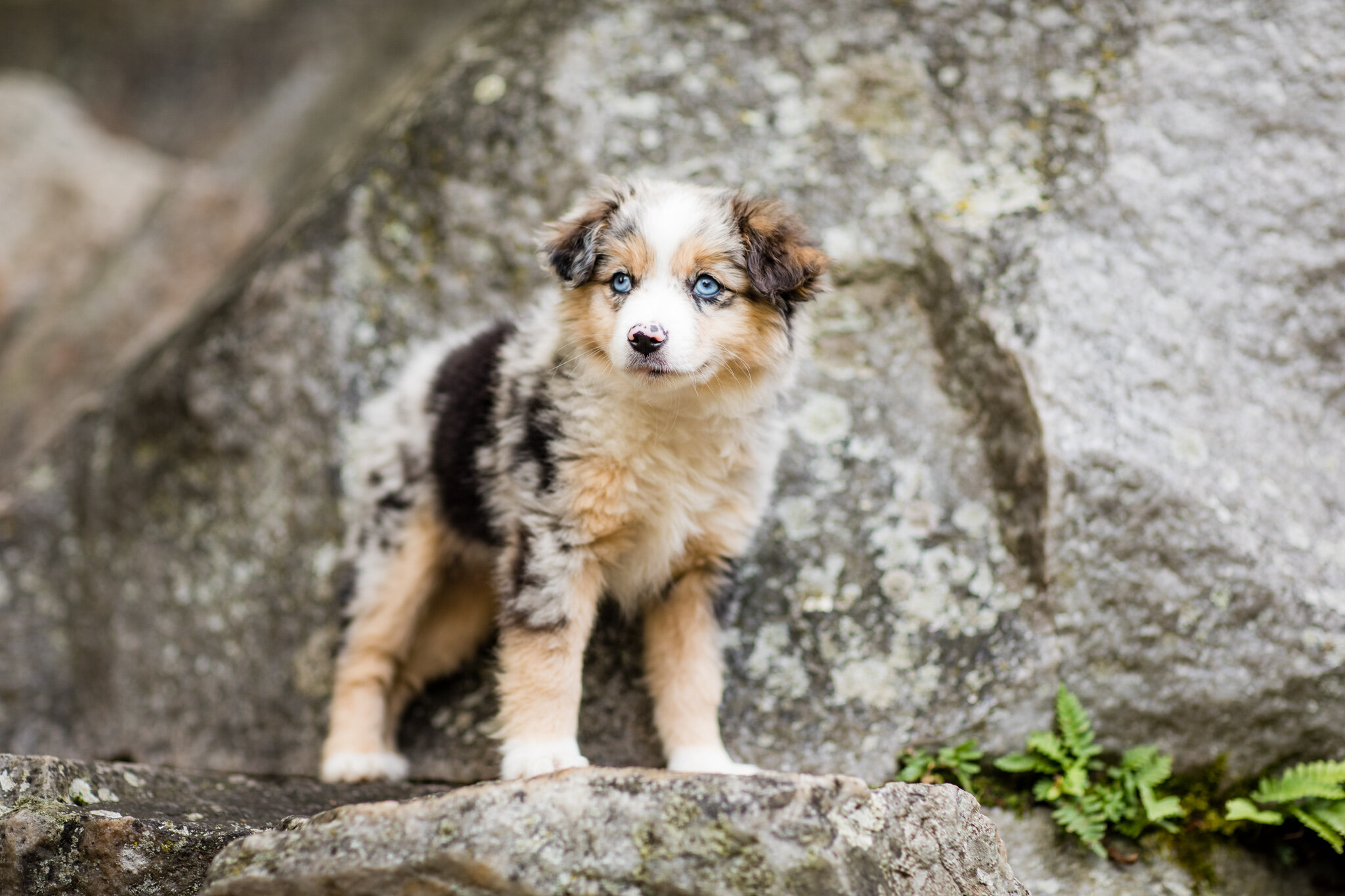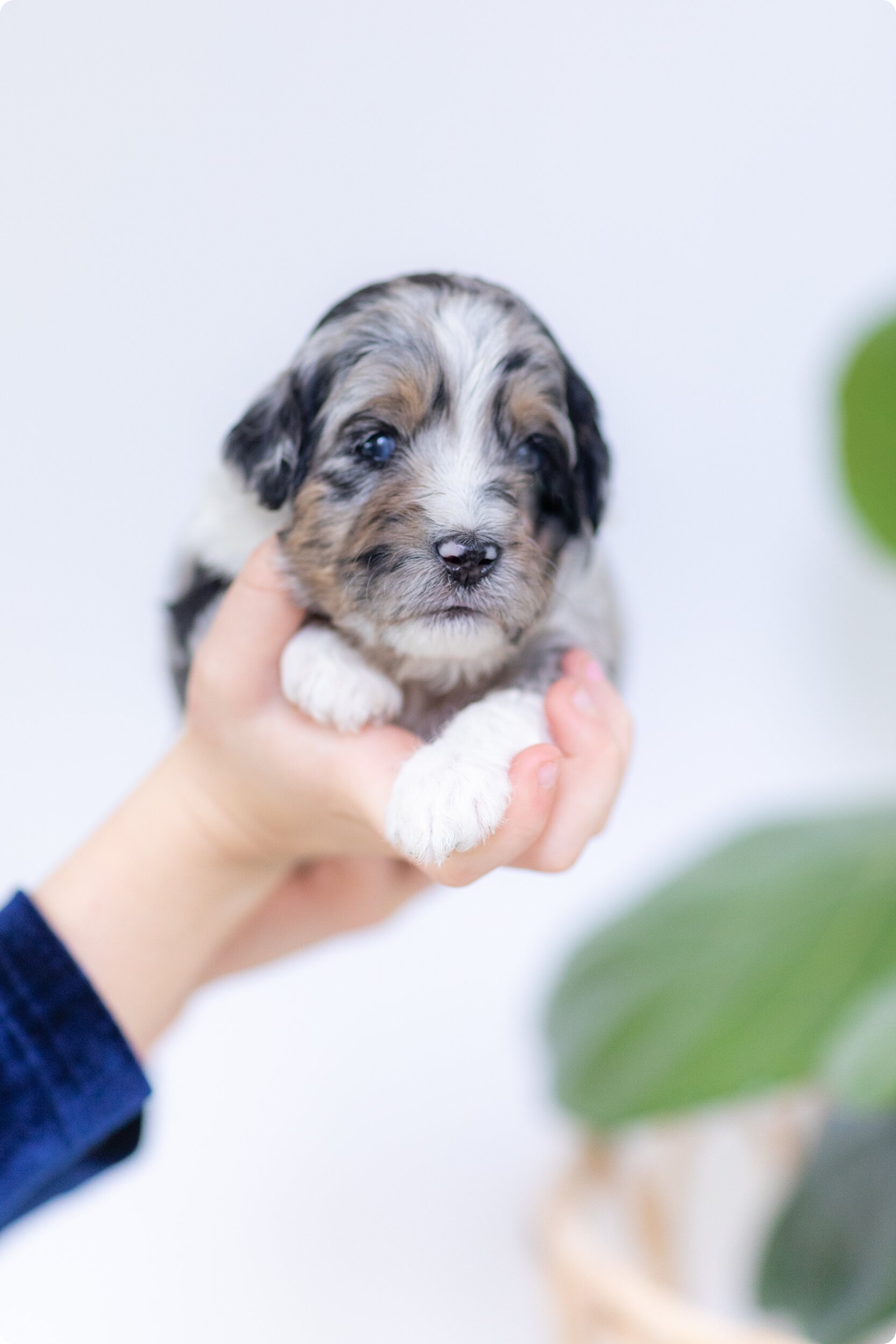Unraveling the Mystery of Blue-Eyed Doodles: Exploring Genetics and Charm
Unraveling the Mystery of Blue-Eyed Doodles: Exploring Genetics and Charm
In the world of designer doodle dogs, everyone is drawn to their beautiful blue eyes. These eyes are especially striking in certain breeds of doodles, which makes people curious about where this trait comes from. The evolution of dogs from wolves involved humans choosing which traits they wanted, creating a wide range of genetic diversity in dogs. Because dogs have similar physical traits and diseases to humans, they are useful for genetic research. Blue eyes, like the ones found in Siberian Huskies, are particularly fascinating. People wonder why some dogs have blue eyes and what advantages they might have, similar to how Europeans have blue eyes. While we know that certain genetic factors can make a dog's coat and eyes blue, there are still unanswered questions, especially in breeds like Australian Shepherds. To find out more about the genetics of blue eyes in dogs, a study was done using a large group of genetically tested dogs with owners who provided detailed information about their dog's appearance. This study aimed to understand the genetic makeup of blue eyes in different types of dogs, including purebred and mixed-breed dogs.
The Elegance of Blue-Eyed Doodles
From the soulful gaze of a Blue Merle Australian Mountain Doodle to the striking appearance of a Blue-Eyed Goldendoodle, these enchanting dogs draw attention wherever they go. But why do some doodles possess such captivating blue eyes?
Stokeshire Breeds that Can Have Blue Eyes
Doodle with Blue Eyes
1. Australian Mountain Dog (AMD)
Australian Mountain Dog with Blue mix Eyes
A harmonious blend of Australian Shepherd, Mini American Shepherd, and Bernese Mountain Dog genes.
Showcases the intelligence, activity, and striking appearance of its diverse ancestral breeds.
Known for mesmerizing coat colors and often inherits captivating blue eyes.
2. Aussiedoodle
A delightful cross between the Australian Shepherd and Poodle.
Combines the intelligence and activity of the Australian Shepherd with the hypoallergenic coat of the Poodle.
Varied in size, coat type, and temperament, suited for various lifestyles.
3. Australian Mountain Doodle
A fusion of the Australian Mountain Dog (AMD) and Poodle lineage.
Inherits the best traits from the AMD and Poodle, offering intelligence, activity, and a hypoallergenic coat.
Known for its adaptability and versatility in different living environments.
4. Bernedoodle
This breed can carry a piebald or parti gene, particularly around the face, called “blaze”, inherited from the Bernese Mountain Dog lineage.
Contrary to popular belief, the Bernedoodle can also inherit the merle gene from the Poodle lineage.
Known for its mix of Bernese Mountain Dog and Poodle traits, such as intelligence, affection, and a hypoallergenic coat.
Varied in coat patterns, including striking piebald or parti coloring around the face, along with the potential for the merle gene, adding to its distinctive appearance and charm.
5. Australian Shepherd & Mini American Shepherd/ Toy Aussie
Mini Aussies
The bedrock of our program is the Australian Shepherd and Mini American Shepherds
Offer a variety of sizes that we pair with Poodles and Bernese to achieve our AMD, but they do shed with a double coat.
They are called “velcro” dogs because they are so human-focused and attentive.
They are more trainable than Bernese but do require more exercise and metal stimulation.
The Science Behind Blue Eyes in Doodles
Blue eyes in certain doodle breeds are closely associated with genetics. Although not all doodles possess this trait, it is more frequently seen in those with the Merle gene. Through research, scientists have identified a duplicated DNA sequence near the ALX4 gene on chromosome 18 as the cause of blue eyes in dogs. This finding has explained the occurrence of blue eyes in breeds such as Siberian Huskies and tri-colored Australian Shepherds, which were previously unexplained by known genes related to coat color traits like Merle and Piebald.
The Mystery Behind Blue Eyes in Dogs Unveiled
Blue Eyed Australian Mountain Doodle
The Merle gene makes patches of color on a dog's coat, and it also affects their eye color. When a dog has the Merle gene, their eyes often turn blue. Blue eyes in dogs are rare and captivating. It's not because of a blue pigment, but rather a lack of melanin that scatters light and makes the eyes look blue, similar to how the sky appears blue.
Genetics: The Blueprint of Eye Color
Much like human eye color, genetics wield a significant influence over a dog’s ocular presentation. Let’s delve into the genetic underpinnings of this captivating trait.
The "Blue Eye" Variant
The association of blue eyes with Siberian Huskies isn’t coincidental. Huskies, among other breeds like Alaskan Klee Kai and Australian Shepherds, often harbor a variant in the ALX4 gene, predisposing them to blue eyes. Remarkably, this dominant trait means that possessing just one copy of the variant could result in those striking blue peepers.
However, this trait remains a rarity, with only approximately 5% of dogs exhibiting the blue eye variant through DNA testing.
Heterochromia Iridis: A Singular Sight
Genetic variations don’t uniformly affect both eyes. Consequently, dogs may present with heterochromia iridis, showcasing one blue eye alongside another of a different hue. This charmingly distinctive trait, also known as “odd eyes” or “split eyes,” adds an enigmatic allure to a dog’s appearance.
Piebald Variant and Merle Gene: Painting with Genetics
The white spotting or piebald variant, often associated with breeds like Boxers and Dalmatians, arises from a localized lack of pigment, sometimes leading to blue eyes in mostly white dogs carrying two copies of the gene. However, it's essential to note that such dogs are at a higher risk of deafness.
Our Nora has one blue eye from her Piebald Gene - which is from her father, a toy poodle.
Similarly, the merle gene variant, responsible for the characteristic coat patterns of various breeds including Australian Shepherds and Border Collies, can also induce blue eyes. Breeding two carriers of the merle gene can result in significant health issues for the offspring, emphasizing the ethical implications of breeding practices.
In various dog breeds, the Piebald gene, denoted as sP on the S-locus, is prevalent. This gene, associated with the MITF gene, causes interruptions in pigmented coat patterns, resulting in spotted or multicolored coats. Dogs with mostly white bodies or solid colors adorned with spots and patches, particularly on the head and neck, are often termed piebald. This allele is recessive, meaning dogs with two copies exhibit this distinctive coat pattern, while carriers with one copy can display a solid-colored coat.
Beyond Genetics: Other Causes of Blue Eyes in Dogs
While genetic variations primarily dictate blue eyes in dogs, several other factors contribute to this striking ocular trait.
Puppyhood Blue: A Transient Charm
All puppies initially sport blue or bluish eyes at birth, a hue that typically evolves to their true color, often brown, around 16 weeks of age. Hence, a young, blue-eyed pup might undergo a color transformation as they mature.
Albinism and Health Conditions
Rare occurrences of albinism, resulting in dogs with minimal to no melanin, can lead to pale blue or green eyes. Additionally, certain health conditions like cataracts, glaucoma, or corneal dystrophy may manifest as a cloudy, grey-blue appearance in a dog’s eyes, signaling the need for veterinary attention.
The Scientific Unveiling of Doggy Blue Eyes
Recent scientific endeavors, led by experts at Embark Veterinary, Inc. and Cornell University's College of Veterinary Medicine, have shed new light on the genetic mutations underlying blue eyes in dogs.
Through extensive genetic marker comparisons from thousands of dogs, researchers unveiled key associations on specific canine chromosomes linked to the merle color pattern and an uncharted region on chromosome 18. This discovery opens doors for further exploration into the complex genetic landscape of dog eye coloration, potentially offering insights into broader health conditions.
While the allure of blue eyes in dogs remains a captivating curiosity, understanding its genetic basis not only enriches our appreciation for canine diversity but also unveils the intricate tapestry of genetics shaping our beloved companions.
Doodles with Blue Eyes: Which Breeds?
Several doodle breeds may carry the potential for blue eyes:
Australian Labradoodles: Especially the Blue Merle variation, where blue eyes often accompany the unique coat pattern.
Goldendoodles: While less common, certain Goldendoodles, particularly those with a Merle lineage, may display blue eyes.
Bernedoodles: Inheritors of the Merle gene can also manifest captivating blue eyes amidst their distinctive coat colors.
The Complexity of Canine Eye Color Genetics
Understanding eye color in dogs involves unraveling a complex interplay of genes. While blue eyes can be stunning, they are often a result of specific genetic combinations. Factors such as pigment production, melanin distribution, and the presence of certain genes all contribute to the final eye color.
Which Dogs Typically Have Blue Eyes?
Apart from doodle breeds, blue eyes can be observed in several other dog breeds, including:
Siberian Huskies: Known for their striking blue eyes, a hallmark of the breed.
Australian Shepherds: Often seen in Merle variations, with blue eyes enhancing their distinctive appearance.
Border Collies: Some Border Collies carry the Merle gene, leading to blue or partially blue eyes.
Embracing the Unique Beauty of Blue-Eyed Doodles
While blue eyes in doodles remain a captivating feature, responsible breeding practices are crucial. Breeders must prioritize health and well-being while preserving the aesthetic appeal associated with certain traits.
Final Thoughts
The charm of blue-eyed doodles extends beyond mere aesthetics; it embodies the intricate dance of genetics and the beauty of diversity within dog breeds. Understanding the science behind their eye coloration enriches our appreciation for these enchanting canine companions.
In conclusion, the world of designer doodles continues to mesmerize with its unique blend of traits, and the emergence of blue eyes adds yet another layer of fascination to these beloved breeds.
Here at Stokeshire Designer Doodles, we celebrate the diversity and beauty of our furry friends, cherishing their individuality while promoting responsible breeding practices.
Sources:
Sams, Aaron. “Embark Discovers Why Dogs Have Blue Eyes.” Embarkvet, 4 Oct. 2018, embarkvet.com/resources/embark-discovers-why-dogs-have-blue-eyes/. Accessed 21 Dec. 2023.
Wisdompanel.com, Wisdom Health, 15 Mar. 2021, www.wisdompanel.com/en-us/blog/blue-eyes-in-dogs#contributors. Accessed 21 Dec. 2023.
Deane‐Coe, Petra E, et al. “Direct-To-Consumer DNA Testing of 6,000 Dogs Reveals 98.6-Kb Duplication Associated with Blue Eyes and Heterochromia in Siberian Huskies.” PLOS Genetics, vol. 14, no. 10, 4 Oct. 2018, pp. e1007648–e1007648, journals.plos.org/plosgenetics/article?id=10.1371/journal.pgen.1007648, https://doi.org/10.1371/journal.pgen.1007648. Accessed 21 Dec. 2023.
“Genomia: Testing of Dogs: White Spotting.” Genomia.cz, 2023, www.genomia.cz/en/test/spotting/. Accessed 21 Dec. 2023.





